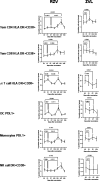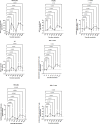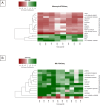This is a preprint.
Trained Immunity Generated by the Recombinant Zoster Vaccine
- PMID: 39041035
- PMCID: PMC11261968
- DOI: 10.21203/rs.3.rs-4607744/v1
Trained Immunity Generated by the Recombinant Zoster Vaccine
Abstract
Trained immunity may play a role in vaccine-induced protection against infections. We showed that the highly efficacious recombinant VZV-gE zoster vaccine (RZV) generated trained immunity in monocytes, natural killer (NK) cells, and dendritic cells (DCs) and that the less efficacious live zoster vaccine did not. RZV stimulated ex vivo gE-specific monocyte, DC and NK cell responses that did not correlate with CD4 + T-cell responses. These responses were also elicited in purified monocyte and NK cell cocultures stimulated with VZV-gE and persisted above prevaccination levels for ≥ 4 years post-RZV administration. RZV administration also increased ex vivo heterologous monocyte and NK cell responses to herpes simplex and cytomegalovirus antigens. ATAC-seq analysis and ex vivo TGFβ1 supplementation and inhibition experiments demonstrated that decreased tgfβ1 transcription resulting from RZV-induced chromatin modifications may explain the development of monocyte trained immunity. The role of RZV-trained immunity in protection against herpes zoster and other infections should be further studied.
Keywords: adaptive NK cells; monocyte immunologic memory; older adults; recombinant zoster vaccine; trained immunity; zoster; zoster vaccines.
Conflict of interest statement
Declaration of interests: AW receives research grants from GlaxoSmithKline and Merck and personal fees from GlaxoSmithKline; MJL receives research grants and personal fees from GlaxoSmithKline and Curevo Vaccines. All other authors report no COI.
Figures






Similar articles
-
Comparative Antibody Responses to the Live-Attenuated and Recombinant Herpes Zoster Vaccines.J Virol. 2021 May 24;95(12):e00240-21. doi: 10.1128/JVI.00240-21. Print 2021 May 24. J Virol. 2021. PMID: 33762414 Free PMC article. Clinical Trial.
-
Development of antibody-dependent cellular cytotoxicity in response to recombinant and live-attenuated herpes zoster vaccines.NPJ Vaccines. 2022 Oct 25;7(1):123. doi: 10.1038/s41541-022-00545-2. NPJ Vaccines. 2022. PMID: 36284110 Free PMC article.
-
Adjuvanted recombinant zoster vaccine in adult autologous stem cell transplant recipients: polyfunctional immune responses and lessons for clinical practice.Hum Vaccin Immunother. 2021 Nov 2;17(11):4144-4154. doi: 10.1080/21645515.2021.1953346. Epub 2021 Aug 18. Hum Vaccin Immunother. 2021. PMID: 34406911 Free PMC article. Clinical Trial.
-
Immune responses to zoster vaccines.Hum Vaccin Immunother. 2019;15(4):772-777. doi: 10.1080/21645515.2018.1560918. Epub 2019 Jan 24. Hum Vaccin Immunother. 2019. PMID: 30676834 Free PMC article. Review.
-
Development of adjuvanted recombinant zoster vaccine and its implications for shingles prevention.Expert Rev Vaccines. 2018 Jul;17(7):619-634. doi: 10.1080/14760584.2018.1495565. Epub 2018 Jul 20. Expert Rev Vaccines. 2018. PMID: 30028651 Review.
References
Publication types
Grants and funding
LinkOut - more resources
Full Text Sources
Research Materials

